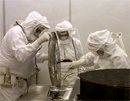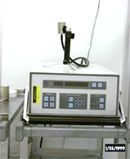




|
 |
 |
  |
|
 |
| This science module focuses on the Genesis
cleanroom. If you are using Genesis science modules for the
first time, read the User's
Guide thoroughly before you begin. (View User's Guide
as aPDF.)
The Portable Document Format (PDF) is
used to distribute fully formatted, print-quality
documents electronically. The following
information is available to view and
print as a PDF file with Adobe's Acrobat
reader. To install the FREE Adobe Acrobat
Reader, visit the Adobe
Web site. Take a look at other science
modules available. All technical
terms in the science modules are compiled
in the Glossary for
easy access. The Genesis
Cleanroom Trilogy page features
the Genesis Cleanroom Interactive Field
Trip and the Cleanroom Technology video
that accompany this module. This module contains video clips which
accompany the Briefing section
and the student texts, "The
Cleaning Room," in the Exploration section
and "Scientific
Symphony and Tool Time" in
the Interaction/Synthesis section.
You will need to download the FREE QuickTime
Player to access these clips. Visit the QuickTime
site to download.
|
|
|
|
|
|
Adobe's
Acrobat Reader©

The
Portable Document Format (PDF) is used to distribute
fully formatted, print-quality documents. |
|
QuickTime
Player

Some
materials in this module require QuickTime to access.
Download the free player here. |
|
|
|
|
|
|
|
|
|
|
|
|
|
|
|
|
|
|
|
|
|
|
|
|
| | |
 |
|
| | |
 |
| The Genesis laboratory
cleanroom was used for the assembly of the Genesis mission scientific
payload
hardware, including assembly of the solar wind collector arrays,
and will be used for handling the solar wind samples after they
have been returned to the Earth. A very clean room is needed during
assembly and sample handling in order to minimize contamination
of the sample. Because the scientists are looking at very small
elemental abundances of the solar wind isotopes, even small amounts
of contamination, like dust from the air, could make it difficult
to see the solar wind samples. NASA has built a class 10 cleanroom
so that neither contamination nor debris will mask the solar wind
samples and throw off the results. In the accompanying video, "Cleanroom
Technology: NASA Genesis Mission," students will learn
about the conditions that are necessary for the assembly of the
spacecraft scientific payload. The "Levels of Clean" activity gives
students a hands-on way of learning how contamination
can move from one room to another. In "How
Clean is Clean?" students will read an analogy
from everyday life to help them understand the
importance of keeping doors closed.
|
|
 |
Curriculum
Connections
National Standards Addressed
National
Science Education Standards Grades 5-8
Science as Inquiry | - Abilities necessary to do scientific inquiry
- Understandings about scientific inquiry
| Physical Science | - Properties and changes of properties in matter
- Motions and Forces
- Interactions of Matter and Energy
| | Earth and Space
Science | - Structure of the Earth System
| | Science and
Technology | - Understandings about Science and Technology
- Abilities of Technological Design
| Science in
Personal and Social Perspectives | - Science, Technology and Society
- Risk and Benefits
| Grades
9-12 Physical Science | - Structures and Properties of Matter
| | History and
Nature of Science | | | Science in Personal
and Social Perspectives | - Personal and community Health
|
|
|
|
| | |
 |
|
| | |
 |
In the activities of this module,
the teacher's primary role is Socratic. Through effective questioning,
students should become aware of the unique environment of the
cleanroom. In the Student Activity, "Suiting Up," students
will learn about the importance of contamination control. The
focus of the activity is the parallel between suiting up for
the Genesis cleanroom and dressing to do a specific job or
activity. The Student Activity, "Washing Dishes," takes students
through a series of steps in which they will test and observe
how soap breaks up contamination in both a guided and open
inquiry. The Student Activity, "How Clear is the Water?" illustrates
how a Secchi disk that a student can make is similar to the
liquid particle counter that is used in the cleanroom. Students
model the process of verifying clean on a macroscopic level
and read about how a liquid particle counter works on a microscopic
level in "From Macroscopic to Microscopic." A simulation
of the liquid particle counter can be found on the Cleanroom
Interactive Field Trip.  In
the Student Activity, "Mapping it Out," students
map out the actual placement of the wafers on the array by
making a color key, then finding and coloring the locations
on five arrays. Once the arrays have been mapped, students
will discover why the wafers have varying thicknesses. In
the Student Activity, "Mapping it Out," students
map out the actual placement of the wafers on the array by
making a color key, then finding and coloring the locations
on five arrays. Once the arrays have been mapped, students
will discover why the wafers have varying thicknesses.
|
|
| | | | |
| | | |  Use
the Student Activity, "Keep it Clean" to create
interest in learning more about how the air quality
in the cleanroom is monitored. Through a simulation,
students learn about sampling and test various places
in a simulated cleanroom. Use
the Student Activity, "Keep it Clean" to create
interest in learning more about how the air quality
in the cleanroom is monitored. Through a simulation,
students learn about sampling and test various places
in a simulated cleanroom.
"Maintaining Clean" is a text that explains sampling
methods and the air particle counter used in the cleanroom.
Planning is the first step taken whether planning a party or
building a spacecraft. Students learn the importance of planning
by comparing what the scientists did when planning the assembly
of the science canister to their task.
|
|
| | |
 |
|
| | |
 |
Student interactions with peers
are emphasized as the class pursues the tasks set forth in
the activity, "Working Together." This
activity contains work to be done in groups, with the whole
class participating in reading and questions found in "A
Scientific Symphony and Tool Time."
|
|
| | |
 |
|
| | |
 |
| In the assessment activity, "Putting it all
Together," students are asked to put together what they have
learned in this module to finish the work started in "Working
Together." This time however, they will be responsible for
planning the work, wearing gloves, washing the tools ahead of time,
and following the map they colored in "Mapping it Out" to
complete the project. |
| |
| |
| | |
 |
|
| | |
 |
|
| | | | |
| |
 |
|
| | | | Module Writer: | ~John Ristvey, McREL | | Contributing Writer: | ~Jacinta Behne, McREL | | Graphics: | Judy Counley, McREL
| | Layout: | ~Amy Hoza, McREL
|
| | Field Trip Designers/Writers: | ~Greg Rawls, McREL
~John Ristvey, McREL
| | Field Trip Technical Development: | 
Viewmark, Inc.
Englewood, Colorado
| | Special thanks to the following reviewers: | ~Dr. Gil Yanow, Jet Propulsion ~Laboratory
~Dr. Kimberly Cyr, NASA Johnson Space Center
~Joe Miller, Clear Creek ISD, TX
~Dr. Donna Bogner, McREL
~Jacinta Behne, McREL
~Glen Taylor, McREL
|
|
|
| | | | |
| | | | |
| | |
